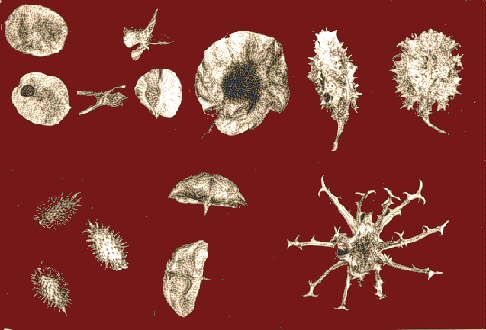From the left to the right, upper row: distribution by wind. Flat, very light, small and dry pods with a relatively large surface and just one or two seeds per fruit (Lunaria annua, Brassicacea).- "Bodenroller" (winged fruits rolling along the ground): three-dimensionally built, dry and very light fruits that are easily blown away in dry habitats (Pterodiscus ungamicus, Pedaliaceae) - distribution by wind, burdocks and "Bodenroller" (winged fruits rolling along the ground), a triple strategy. Flat, dry involucre with a large surface but rather heavy. It can therefore only travel short distances by wind alone. The spiky centre serves epizoochoric distribution by animals; the arrangement of the wing-like gadgets allows an additional drifting at the floor (Pterocarpus angolensis, Fabaceae).- trample burs: lignified fruit shell with spikes and barbs that stick to the softer parts of mammals' hoofs and are dispersed this way (Harpogophytum procumbens, Pedaliaceae).

Lower row: distribution by burdocks: dry fruits with barbs at their surfaces that stick to the fur of mammals. Relatively strong structure of the fruit that falls apart by and by so that the seeds are very effectively lost at different places (Xanthium riparium, Compositae)- trample bur: dry and very compactly built fruit with a "drawing pin-principle". This fruit is only dispersed by the hoofs of mammals, it cannot adhere to their fur (Dicerocargium senecioides, Pedaliaceae) - and one more trample bur: this one can also stick to animals' furs. The fruits are, too, able to cling one to another. The respective animal may be hurt by the spikes (Harpogophytum procumbens, Pedaliaceae) (leg. et det. H.-D. IHLENFELDT, photos by A. FOCK, 1985)